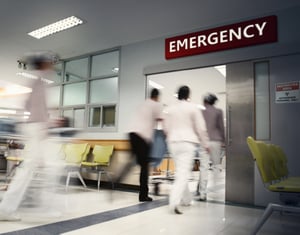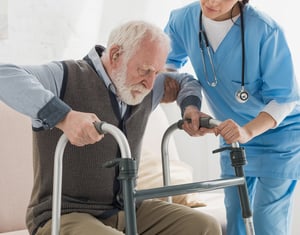Table of Contents





Introduction
All healthcare organizations should anticipate, plan for, and be prepared to effectively respond to emergencies in their healthcare setting. Drills, simulations, and tabletop exercises can highlight knowledge deficits or gaps in expected response. They are useful for subsequent staff training on established protocols and identifying unique role-based responsibilities during emergencies.
Tabletop exercises are used in many industries but can be particularly relevant in the healthcare setting. A tabletop exercise is an informal, collaborative discussion to review emergency scenarios or unexpected situations that could arise in a particular setting. These sessions are intended to help organizations develop the roles that key team members may play and their responses during specific emergencies. They are also meant as a collaborative meeting where leaders and subject matter experts present an emergency scenario and allow the team to work through the organization’s response protocol based on organizational policies, procedures, and industry best practices. The key to conducting these exercises is to allow candid, thought-provoking discussion to identify gaps in existing protocols to help your organization build a more successful and situationally appropriate response to emergencies.
- Identify potential hazards specific to your practice location, patient population, and facility type, including patient emergencies, system disruptions, hostile patient behavior, and weather events.
- Clarify the departments and specific staff roles that will be impacted by an emergency and outline their unambiguous responsibilities and particular duties during an emergency response.
- Develop a written emergency plan outlining the specific steps that staff should follow during an emergency.
- Focus on triage and prioritization of patient care during an emergency based on the availability of supplies and equipment as well as possible transfer needs.
- Establish direct communication channels with staff, patients, families, and external partners to provide updates and coordinate efforts as needed during an emergency.
- Allocate resources such as designated funds, human capital, and other resources to maintain a readily accessible inventory of essential medications, equipment, and provisions for use in an emergency.
- Conduct training sessions for team members to better recognize the triggers for initiating emergency response procedures.
- Conduct training sessions to ensure team members are competent in emergency response, including proficiency in administering first aid, basic life support (BLS), or CPR; appropriately calling 911 for assistance; and understanding evacuation or shelter-in-place protocols.
By engaging key staff in a proactive conversation, the practice can more carefully plan, prepare for, and practice a potential emergency scenario. Medical staff and leadership will then be better positioned to support staff and patients during emergencies.
|
For additional information, please watch our "2 Minutes: What’s the Risk?" Emergencies in the Medical Office Setting. For any questions, please contact us at RiskAdvisor@ProAssurance.com or 844-223-9648. |
What Is Expected During a Tabletop Exercise?
These exercises take place, as the name suggests, at a table (or tables) in a conference room type setting. The typical exercise should only take about an hour to complete.
Leadership buy-in, regardless of practice size, is imperative for these exercises to be successful. Depending on the scenario being reviewed during the exercise, participants could include:
- Front-line staff such as practice managers, registration, front desk, medical assistants, nursing, practitioners, and lab and radiology techs
- Administration and management staff such as CEO, CMO, CNO, CFO, COO, legal/compliance department, human resources, and team managers
- Organizational support staff such as call center, maintenance, environmental services, IT, risk management, quality improvement, supply chain, pharmacy, and laboratory.
For smaller practices that may not have multiple leadership positions, the list of management or lead personnel attendees may be much smaller and include different role types. In a small practice, the tabletop exercise attendees may include a practice owner or manager, principal provider, and lead nurse. Tabletop exercises are designed to apply to your practice’s unique setup and staff ratios.
A constructive part of the discussion may include the realization that certain coworkers or departments valuable to the discussion were not in attendance and should be included in the next session. All participants should record their attendance on a sign-in sheet to capture team members that completed the exercise.
During the exercise, attendees discuss an emergency that could feasibly occur at the practice. Participating individuals should discuss and confirm which departments and specific roles would be impacted and, therefore, should play a part in the response. It is important to discern if participants are aware of the existence of or the need for a relevant governing organizational policy or procedure. Taking these factors into account, the team will seek to lay out the consequences of the emergency, which staff must act, when they should act, and what sequential actions they will need to take individually or in tandem with other departments. Consider providing copies of relevant policies at the time of the exercise for review with the team.
The process of presenting a full-blown emergency scenario to relevant staff may yield surprising results. Oftentimes, the organization and staff members themselves realize that there is a learning gap when it comes to awareness of active policies and their content. There may be an assumption that the duty to react is someone else’s responsibility, or maybe a misunderstanding of how many and which departments should take action to mitigate the emergency. These exercises are beneficial and eye-opening, pointing out areas for continued or focused training and mindfulness. A tabletop exercise is an efficient preliminary step to a simulation or mock drill.
Consider assigning key tasks to team members along with realistic timelines to complete. Included with this packet is an evaluation form to record opportunities identified during the exercise.
Review policies and procedures for accuracy and update them as needed based on the results of the exercise.
Work the improvements into your Quality Improvement program and include any emergency response team members, if applicable.
The information provided offers risk management strategies and resources. Guidance and recommendations contained in these materials are not intended to determine the standard of care but are provided as risk management advice only. The ultimate judgment regarding the propriety of any method of care must be made by the healthcare professional. The information does not constitute a legal opinion, nor is it a substitute for legal advice. Legal inquiries about this topic should be directed to an attorney.
Case Scenarios
The tabletop exercise structure can accommodate any emergency you might encounter. We’ve posted several of the most common scenarios here. Each downloadable PDF below includes everything you need to plan an exercise: the explanatory information above, administrative tracking forms, and the scenario-specific content. We plan to develop additional scenarios over time. If you have recommendations for new scenarios, send us a request to RiskAdvisor@ProAssurance.com.





